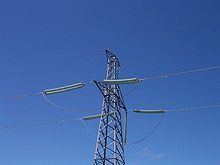Country ItalyFrance Total length 385 km (239 mi) Operator Terna Group | Commissioned 1967, 1988, 1992 Number of poles 2 | |
 | ||
Manufacturer of substations AnsaldoEnglish ElectricAlstom Type of current High-voltage direct current | ||
The HVDC Italy–Corsica–Sardinia (also called SACOI; Sardinia–Corsica–Italy) is an HVDC interconnection used for the exchange of electric energy between the Italian mainland, Corsica and Sardinia. It is unusual, having more than two converter stations as part of a single HVDC system, and (as of 2012) is one of only two Multi-terminal HVDC systems in operation in the world (the other multi-terminal scheme being the Quebec – New England Transmission system linking northeastern United States with Quebec in Canada).
Contents
The scheme is a monopole using a mixture of Overhead line and submarine cable for the 200 kV high voltage conductor, and sea return for the neutral current. The overhead lines and submarine cables are duplicated, with both circuits being installed on the same towers.
The scheme was constructed in three phases.
Converter stations
When originally completed in 1968 by English Electric, the scheme comprised two converter stations, at San Dalmazio in Tuscany on the Italian mainland and Codrongianos on Sardinia. Each converter station was rated at 200 kV, 200 MW and consisted of two 6-pulse converter bridges in series. Normal operation was with both bridges in service but the scheme could be operated at 50% of rated voltage and power by bypassing one converter group at each end, to allow maintenance to be carried out.
Each 6-pulse converter bridge consisted of 6 main Mercury-arc valves plus a 7th for high-speed bypass operations. Each valve was rated at 1000 A dc and had four anode columns in parallel, with air cooling used for both the anodes and cathodes of the valve.
The original scheme was commissioned during 1967 and put into commercial operation in January 1968.
Transmission lines and cables
The scheme consists of three overhead line sections: one on the Italian mainland with a length of 22 kilometres (14 mi), one on Corsica with a length of 156 kilometres (97 mi) and one on Sardinia with a length of 86 kilometres (53 mi). The overhead line sections use twin conductors (each rated at 1000 Adc) connected in parallel. Each conductor has an aluminium conductor cross section of 628 mm2 in Sardinia and Italy, and 755 mm2 on Corsica.
In addition to this, there are two submarine cable sections: 105 kilometres (65 mi) between Italy and Corsica and 16 kilometres (9.9 mi) between Sardinia and Corsica. The cables have conductor cross-sections of 1080 mm2 on land and 420 mm2 for the sea cables.
Sea electrodes
The scheme was designed to export power from coal-fired power stations on Sardinia to the Italian mainland, and thus was only required to operate in one direction. Although the converter stations are inherently capable of operating in either direction of power transmission, advantage was taken of the unidirectional power-flow requirement to economise on the design of the sea electrodes. The sea return current enters the sea at the Sardinian end (Anode) and leaves the sea at the mainland end (Cathode). The mainland electrode consists of bare copper (a section of insulated copper cable with the insulation stripped off), which would corrode rapidly if used as an anode but suffers no degradation when used as a cathode. However, the anode electrode on Sardinia required a more sophisticated design using platinum-coated titanium pipe, subdivided into 30 sub-electrodes, in order to prevent corrosion.
Corsica tap (1988)
In 1988 a third converter station, rated at 50 MW, along with a reversible ground electrode, was installed at Lucciana on Corsica, making the scheme into a multi-terminal scheme for the first time. In order to allow power to be either imported into, or exported from Corsica even though the direction of power flow is always from Sardinia to Italy, the Lucciana converter station was equipped with high-speed changeover switchgear.
Unlike the two original converters, the Lucciana converter station was built with air-insulated, air-cooled Thyristor valves, supplied by CGE Alstom
1992 upgrade
In 1992 the mercury arc converters at Condrongianos and San Dalmazio were decommissioned and two new converters stations built, using air-cooled, air-insulated thyristor valves similar to those supplied for the connection at Lucciana. At the Sardinian end, the new converter station was built next to the existing station but at the mainland end a new converter station was built at Suvereto. At the same time, the rating of the scheme was increased to 300 MW, keeping the same voltage of 200 kV.
